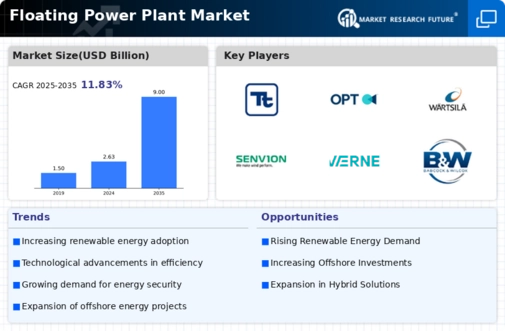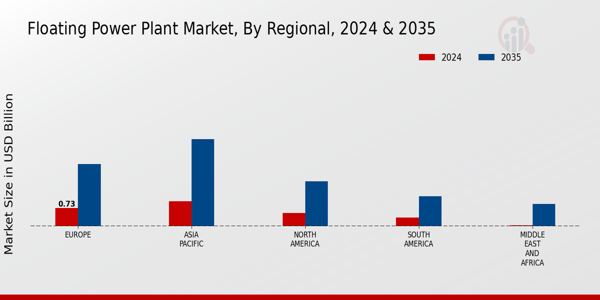Market Trends
Introduction
The Floating Power Plant market is undergoing a significant transformation as we enter the year 2024, driven by a confluence of macro-economic factors. Technological developments in energy production and storage are increasing the efficiency and viability of floating power solutions. At the same time, governments are under pressure to reduce their carbon emissions, and are experimenting with new energy sources such as offshore wind and wave energy. As consumers become more aware of sustainable energy, they are demanding cleaner, more flexible power generation. These trends are strategically important to investors, as they will not only influence investment decisions but also shape the competitive landscape of the energy sector. In order to adapt and thrive in this evolving market, it is essential to take a forward-looking view.
Top Trends
-
Increased Investment in Renewable Energy
The government is putting considerable capital into the development of the new energy sources. For example, the European Union has set aside more than one billion dollars for offshore projects, including offshore wind and floating solar. This is expected to increase energy security and reduce the carbon footprint. The industry is responding with the development of new floating energy technology, which could lead to greater energy efficiency in the years to come. -
Technological Advancements in Floating Platforms
The new materials and the new constructions have rendered the floating platforms more solid and more efficient. The use of light composite materials, for example, has improved both their buoyancy and their duration. These innovations are necessary for the elongation of the life of the floating power stations. As technology develops, it may lead to a system of complete automation, which will reduce operating costs and increase reliability. -
Regulatory Support and Policy Frameworks
A number of countries are establishing regulatory frameworks that favour the establishment of floating power stations. The United States has established a simplified permitting procedure for offshore wind projects that includes floating structures. This clarity of the regulatory framework is vital to attract investment and reduce project times. In the future, a more uniform regulatory framework may be established, which would facilitate international collaboration on floating power station projects. -
Integration with Energy Storage Solutions
Floating power plants are increasingly combining with storage systems. Companies are experimenting with hybrid systems that combine floating solar with batteries to ensure stable power supplies. This increases the reliability of the grid and reduces energy losses. As the technology for storage systems develops, more and more floating power plants are likely to take advantage of them to optimize their performance. -
Focus on Environmental Sustainability
Environmental considerations are the driving force behind the development of floating power plants. In other words, the projects are being developed so as to minimize the ecological impact of their operation, such as by avoiding the disruption of marine life. Not only does this meet regulatory requirements, it also appeals to investors who share this concern. Future projects may thus be designed to make even greater use of sustainable practices, thus enhancing their market value. -
Collaboration Between Public and Private Sectors
The trend of the floating power plant is to be a PPP. The government and the private company are collaborating to share risks and costs, as shown by the offshore wind projects. This collaboration can speed up the development and innovation of the project. The more the PPPs develop, the more comprehensive solutions can be found for both energy and environment. -
Expansion into Emerging Markets
Emerging markets are increasingly recognizing the potential of floating power plants to meet their energy needs. Southeast Asian and African countries are now looking at wind and solar solutions to harness their vast water resources. This trend is expected to spur growth in regions where there is little space for land-based power plants. Future developments may well include bespoke solutions designed to meet the unique requirements of these markets. -
Enhanced Grid Connectivity and Infrastructure
Success of floating power plants depends on the improvement of the connection to the electricity network. These plants require the establishment of a suitable network to transmit their energy to consumers. For example, countries are modernizing their grids to accommodate new sources of energy. Floating power plants could be more easily integrated into the national energy system as grid technology improves. -
Rising Demand for Decentralized Energy Solutions
Interest in floating power stations is growing as a result of the need for decentralized energy solutions. In order to increase resilience and reduce dependence on the centralized grid, communities are looking for their own sources of energy. This trend is already evident in the number of pilot projects that are testing the feasibility of floating solar farms in urban areas. With the benefits of decentralized energy becoming more and more obvious, we can expect a rise in community-led floating power projects. -
Innovative Financing Models
A number of financing models are emerging to support the development of floating power plants. Crowdfunding and green bonds are being used to raise money for the development of clean energy projects. These new sources of finance are overcoming the financial barriers that are preventing many projects from going ahead. When these forms of finance become more established, they may also become a source of additional investment for floating power plant projects.
Conclusion: Navigating the Floating Power Plant Landscape
The Floating Power Plant Market is characterized by a highly fragmented and highly competitive market, with both the old and new players competing for market share. As the focus shifts towards sustainable and green energy, the vendors are forced to come up with newer and more sustainable products. The old players have a clear advantage over the new ones in terms of their technology and their established business, but the new players are focusing on advanced capabilities such as automation, artificial intelligence, and flexibility to differentiate themselves. These advanced capabilities will be essential to lead the market in the future, as they will enable the companies to respond quickly to changes in the regulatory framework and customer requirements. Strategic alliances and investments in technology will be key to strengthening their competitive position in this rapidly changing market.













Leave a Comment